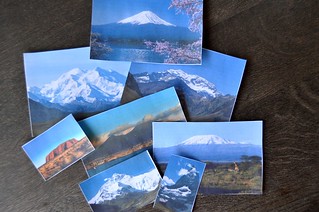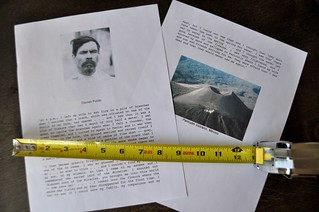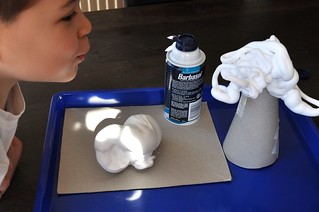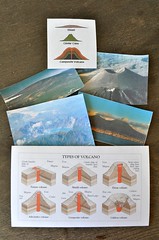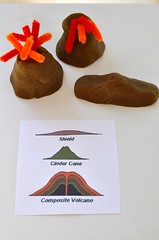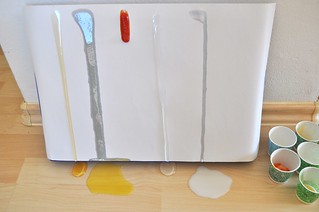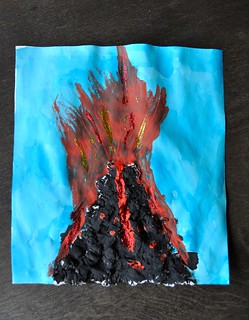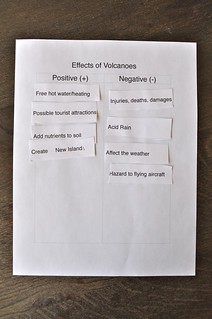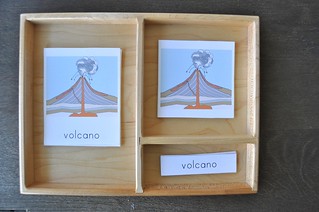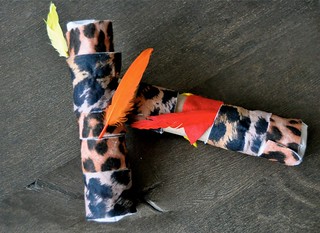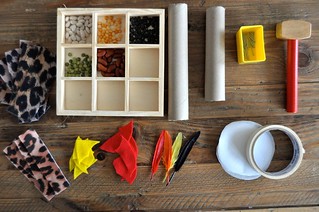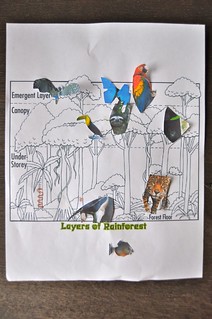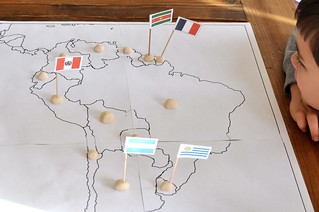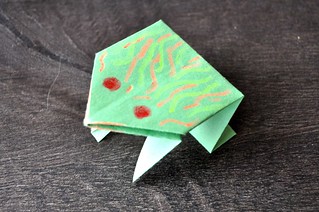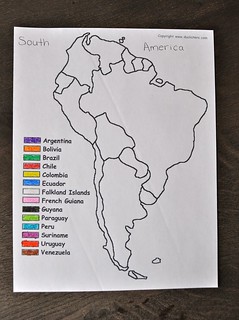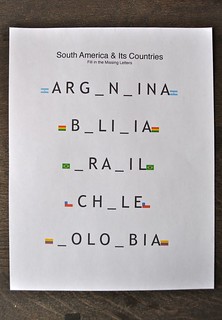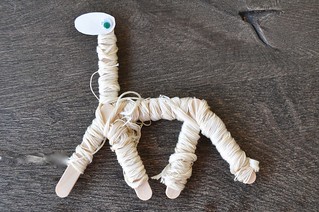Do you happen to live in a volcanic area? We unfortunately don't. I mean, Germany isn't exactly known for its volcanoes, right? Amazingly though, it does have quite a few (about a hundred) but sadly, they do not look the part anymore being that they have been extinct and worn down for millions of years. That doesn't mean my son wasn't thrilled to hear that we had one dormant volcano or that we'd climb to the top of one! Here is the latest on our volcano unit!
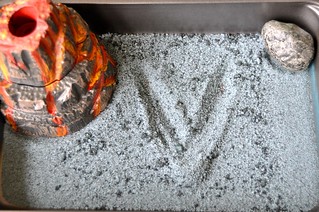 |
| Writing in "Volcanic Sand" |
We've written in sand, salt, shaving cream and such before so this time, we wrote in "volcanic sand". I wish it were real but sadly, little me didn't think ahead and didn't bring back any black sand from the Canary Island beach we lounged on a few years back. I guess I was too busy getting my feet off of it (black sand is really hot by the way!) I made this "pretend volcanic sand" using salt and black food coloring. The plastic rock and volcano are decorations from a toy my son has. We used this tray to practice writing numbers mostly but I also saw my son borrow it to practice writing CVC words.
 |
| Volcanic Versus Non-Volcanic Rocks |
Now these rocks are real! :) We haven't studied rocks yet so this is a new topic and it has opened a HUGE interest in rock collecting! :) With these few rocks, Adrian had to try and determine whether they were volcanic or non-volcanic rocks. Just by looking, it is not so easy. I let him sort and then I gave him a bit of information on how each rock formed to help him decide whether the rock was in the right place or not. The best part of course is simply handling the rocks...and knowing that some of these might be pulverized and laying on a black sand beach somewhere...
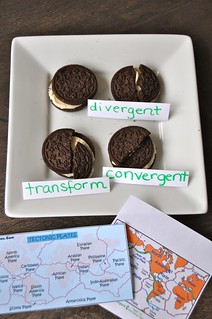 |
| Plate tectonics & Volcanoes |
We learned a lot about volcanoes during our unit...How they grow, what comes out of them, but one question really remained: why are there so many volcanoes in some areas and none in others? It's a tricky question for the younger crowd but with the help of some creme sandwich cookies, it somehow seemed easier to explain...Thus, a big thank you to Prof. Lillie at Oregon State for providing an excerpt of his book into which he explains how plate tectonics work with the help of the delicious cookies.
I started with a simple flat map of Earth stating that Earth's surface is like a big puzzle of 7 big pieces and several smaller ones. These pieces are called plate tectonics. These can and do move. Most of the time, we don't feel them shifting but sometimes we do; for example, there might be an earthquake! Of course, earthquakes, like volcanoes happen more in some places than others. Looking at the first plate tectonic map, I asked my son to point out our location. Ah, we were not close to any of the lines called plate tectonic boundaries. The boundaries is where most of the movement of the Earth is felt. For example, the plates sometimes grind together or pull apart. Now was the time to bring in the yumminess!
We pretended each cookie represented Earth's mantle (hard crust on top, softer mantle in the middle, lower harder mantle in touch with the liquid core of the planet at the bottom). The first cookie simply allowed me to show that a plate can slide around. They are not tight fitting. There is wiggle room. Then came a second cookie to represent a divergent plate. I broke the top, pushed it in the cream a bit and up again and left a crack. We now had a ridge. Iceland has lots of those! How many are deep enough to even let magma through? We moved on to the second plate; a transform plate. Broke the top of my cookie and made one piece grind against the other. This grinding gives us many earthquakes. A bit of the West Coast in the U.S.A. is located at the boundary of a transform plate. No wonder there are so many earthquakes in California! Finally, the last type of plate is the one that was most interesting for our study: the convergent plate, located pretty much all over the Ring of Fire... This cookie was fun. I cracked the top in two and slid one piece under the other broken piece. It did touch the bottom cookie and broke it too...allowing imaginary magma to come to the surface from the liquid core of Earth...
We now knew how plates work, where they are and why volcanoes happen more in some areas. With the plate tectonic maps, Adrian was able to locate lots of volcano sites... and assumed the volcanic islands not at boundaries were born from hot spots. Hello Hawaii and the Canary Islands!
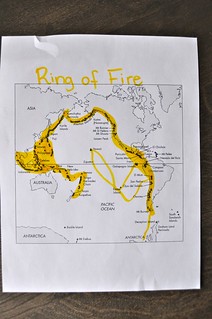 |
| Ring of Fire Map & Highlighting |
Adrian being the volcano lover that he is, he's known for a while that some areas are more prone to others to being host nations. Having explored tectonic plates, I wanted him to discover what effect these really had on the development of volcanoes so I printed a map of the famous Ring of Fire in black and white, showing where the volcanoes are (would provide link but it's already broken...). Adrian then had to "find" the Ring of Fire by highlighting the possible corridor. Of course, he didn't want to leave Hawaii and Easter Island behind so he covered those parts too but overall, he really did find the ring. Then, comparing with the plate tectonic boundary map, I asked him if these volcanoes had developed due to hot spots or due to tectonic plate movements. Without a doubt, he answered that these were located at the boundaries of various plates. These were caused by convergent plates shifting.
 |
| Location & Status of the Decade Volcanoes |
Sixteen volcanoes have been identified as particularly interesting by the IAVCEI. Apparently, these volcanoes should be known to the public and more closely monitored because of their location (close to populated areas) and because of their potential for destruction (they tend to be very destructive). Using a map providing the location of each of these volcanoes, Adrian and I work together to identify the current status of each as of right now. Adrian was very excited to work on this. We went through the map by continent/country and then, color-coded by status (VolcanoDiscovery is great to check out statuses and much more!). It was good geography work. Once the map was completed, we played a little game where I'd ask him to tell me how many of the decade volcanoes are erupting today or how many decade volcanoes are located in Africa, and so on.
 |
| Volcano Eruption Experiment |
Active volcanoes are spectacular to watch for kids. Whether it's a picture, a video or even in real life, it's simply fascinating for them. Being that we live far from most active volcanoes, I resorted to prepare our own! That is something we did last year during dinosaur week so it wasn't going to be new but it was so well received last year that surely, Adrian wouldn't mind...and he didn't. Neither did his sister. I prepared the volcano as I did last year, following Beth's instructions but going a bit heavier on the soap this time (hehehe). Adrian loved making the volcano erupt himself several times and he and his sister loved having the dinos join in the fun.
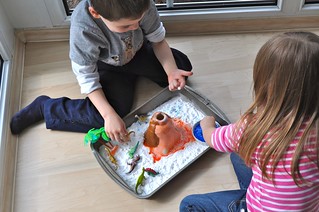 |
| Playing with the bin |
 |
| Melted Wax Crayon Volcano Craft on Canvas |
Of course one piece of art for such an extensive unit was not going to cover for it so we tried this one as suggested by Ms. Lemons. I purchased a small canvas for the kids and let them paint a nice sky and ground with tempera paints and we let it dry overnight. The next day, we picked four "lava-colored" crayons and taped them to our landscape using masking tape. It was now time to make the volcano erupt. With the use of a hair dryer, we melted the crayons. It didn't take that long. It's a slow start but once it's going, it's flowing! I let my oldest try with the hair dryer but he thought it was a bit too noisy and heavy and preferred to cover his ears while I melted the crayons under his fascinated eyes. He somehow did not believe this would work! :) While the wax cooled, the kids each drew a cone shaped volcano on a small paper bag and cut it. Once the wax was completely cooled, we glued it to our crayons and landscape. This craft was, to this day, one of my son's favorites. He is asking to melt more crayons almost everyday now! :)
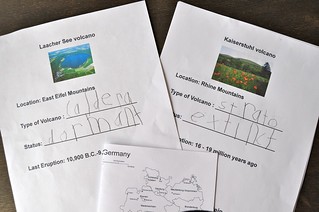 |
| Famous German Volcanoes |
Of course when studying a topic as fascinating as volcanoes, children will often wonder if there are such "mountains of fire" close to them. My son had asked and I thought I'd prepare a small booklet of Germany's Top 3 volcanoes for him. In the folder, he found a map showing where each volcano was but also where he lives as well as a file for each volcano. Together, we read a bit about each to find out their status and type.
 |
| Field trip to a German Volcano! |
"Visiting" a volcano will of course not be possible for everyone but if it is, it makes for a wonderful field trip. My son was oh-so-happy to hike to the top of this very extinct volcano and see all these basalt rocks. Even better, he got to bring one back and the one he picked clearly shows the path the lava went 24 millions years ago!
 |
| Adrian in front of a basalt column |
 |
| A volcanic lunch |
To complete your unit, what's better than an "eruptive" luncheon? Sandwiches are rarely served here because leftovers are usually what's for lunch but when nothing's left, soups and sandwiches are usually the fillers. During our volcano unit, the sandwich was not just any sandwich: it was a volcano; an active one with a ketchup and cheddar cheese lava on a bed of fresh lettuce. Needless to say, the sandwiches had never been so appealing! :)
* * *
Enjoying What You're Reading?
Follow Sorting Sprinkles on Facebook or Sign Up to be Notified When New Posts Are Out!
* * *
This week, I'm happily linking up to
